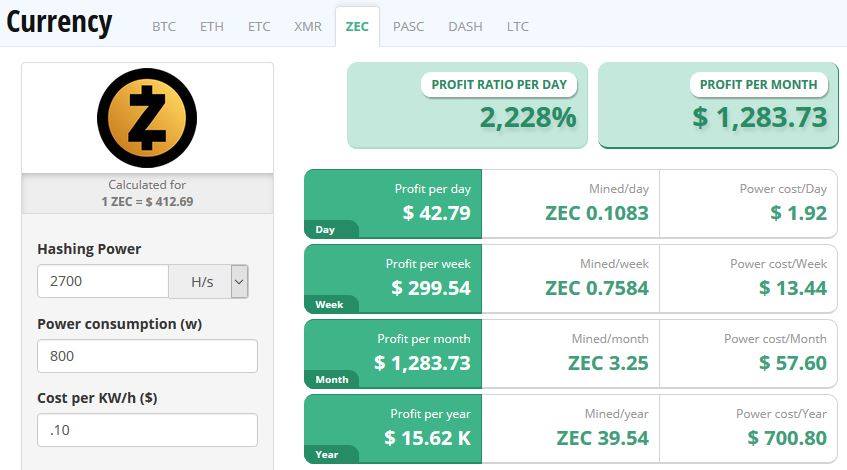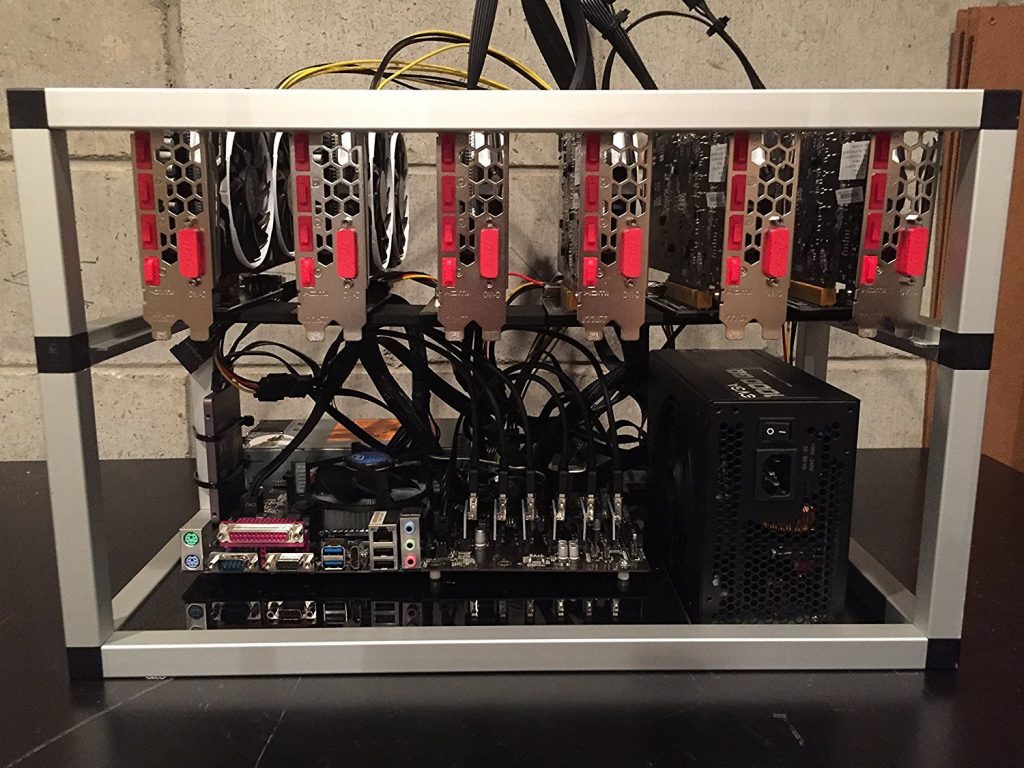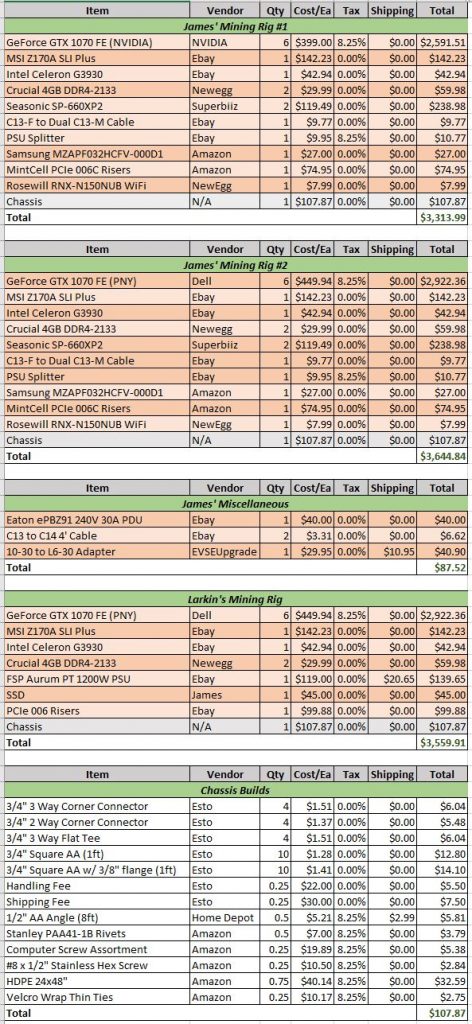Making Money – More Literally Than Not, Part 1
This content has been archived. It may no longer be relevant
I’ve been investing in a variety of things over the years, with varying levels of success. I have money in the stock market, retirement accounts, various (small) startups, and have been eyeing the cryptocurrency markets for quite a while. I strongly considered building a mining rig a couple years ago, but ultimately opted not to, and wish I would have done so. Looking back at the markets, my ROI would have been at least a couple thousand percent. Better late than never, the markets are still going strong, and as of this time, a 6-GPU rig that costs around $3,500 to build makes between $1,000 and $1,300 a month. That’s a quick return, as long as the markets hold. Unfortunately, many people have caught on to this, and almost all of the parts to build these rigs are sold out or being sold on Ebay/Amazon for well more than what they are worth. I bought items two days ago that were selling for 1/3rd of what they are today. It’s absurd. Check out this news article about it.
Cryptocurrency is a term that includes several digital currencies. Each currency is created, bought, sold, and exchanged for goods online. More recently, some of the more popular ones, such as BitCoin, has made it onto paper. And they’ve all been in the news quite a bit. Currency is generated through a process called mining. Mining is very calculation intensive and requires specialized, high power hardware to do in quantities that outweigh the costs. To avoid repeating a lot of information that can be found online, I recommend just reading about it on WikiPedia. Sites like CoinBase and Poloniex provide insight into the market, and the ability to trade USD in and out to various digital currencies.
I decided to invest in two rigs myself, and that prompted a few of my friends to as well. I’m tracking Larkin’s build in my investment spreadsheet for the ease of tracking components, which I’ll post below. Each of our rigs is going to be outfitted with six NVIDIA GTX 1070 graphics cards, a Celeron G3930 CPU, MSI Z170A motherboard, 2x4GB DDR4 RAM, and a SSD boot drive. My setup will be using dual 660w platinum power supplies, while his will use a single 1200w PSU. I mentioned above that many of the parts are hard to come by, which is why I’m using dual PSUs in my builds. I couldn’t find reasonably priced 1200w Platinums. The best currencies to mine for vary day to day and you can either leave it or change as often as you want, but this is the one I’d be working on today if my rigs were going:

There are only a handful of GPUs that are good for mining, and the most popular by far are the ATI Radeon RX580 and the NVIDIA GeForce GTX 1070. Both are very hard to come by, and going for much higher prices than they ordinarily would if not for the mining market driving them up. The GTX 1070 has the lower power usage of the two cards, with around 100w used per card for mining operations, and a maximum requirement of 150w. Power supplies are rated as 80+, 80+ Bronze, Silver, Gold, Platinum, and Titanium. The higher up the chain you get, the more efficient the PSU is. Since we’re in this to make money, you want to keep your power bill at a minimum. The up front investment in Gold, Platinum, or Titanum (Unobtainium) power supplies should pay off in the long run. As a bonus, most of those power supplies achieve those ratings by using much better quality components, and are probably less likely to fail and kill your expensive equipment.
Mining rigs come in all sorts of shapes and sizes, since there aren’t really any mass produced cases for them. I designed an aluminum and HDPE open air chassis, based on something like this:

My design is a lot wider, at 28″, to allow for more spacing between the cards, and more importantly, two power supplies to lay flat at either side of the motherboard. Using the dual PSU approach should allow for tidying up the cables a good bit more than a single PSU design. The overall case design will be 10.5″ deep, 12″ tall, and 28″ wide. The bottom of it will be a solid piece of black HDPE and I’ll be using the same type of aluminum tubing as the above unit. These make a fair amount of noise, heat, and require a lot of power. I opted to put them on a tall shelf in my laundry room. The room has a dedicated A/C vent for no good reason, and we’re rarely in there except to wash clothes. It happens to work out perfectly because we have connections for both electric and gas dryers, but have a gas one. That leaves a dedicated 240V 30A circuit unused in that room. I found a company that makes an adapter for the dryer outlet to charge electric vehicles, and with that adapter I’ll be able to plug in a 240V datacenter PDU I found on Ebay. The PSUs I bought are auto-switching, so I’ll be able to provide them with clean 240V power on a dedicated circuit.
I’ll be posting the progress of my builds as parts come in, but this is the spreadsheet to track the builds:
Between the three builds, the average cost came out to $3,506.24. There was an eight hour discrepancy between ordering the two identical builds, and that hesitation came at a penalty of $330.85 due to stock shortages and vendors raising prices accordingly. My six cards from NVIDIA shipped today, and the ones from Dell are currently on backorder but they’re expecting to ship them on Friday. The rest of the parts are beginning to trickle in today.
This is a huge investment for me, and is going to be very interesting to see if it pays off. As far as investments go, mining cryptocurrency is currently providing far greater yields than anything I’m aware of, and they only seem to be increasing.

